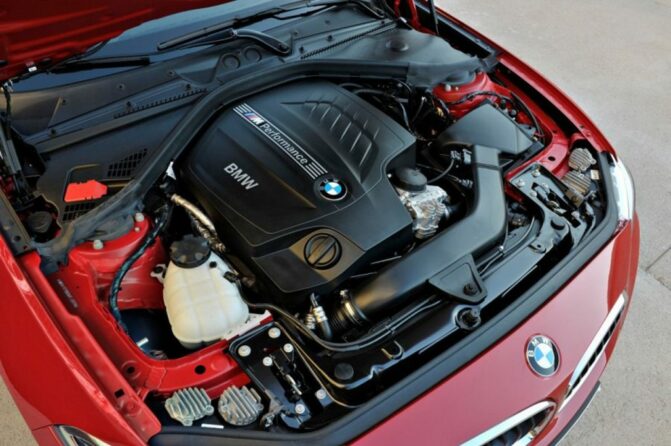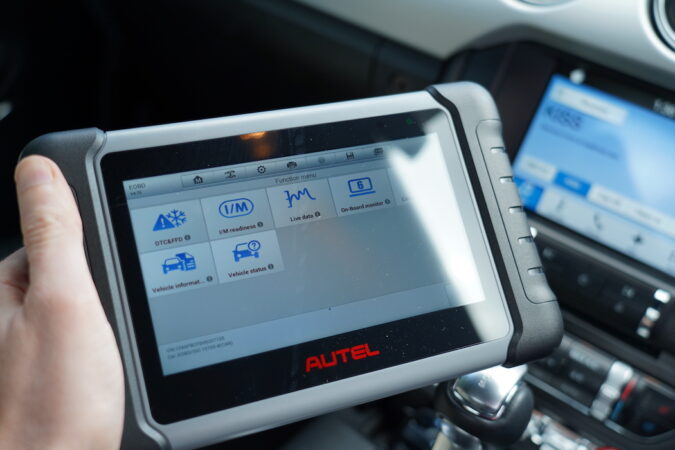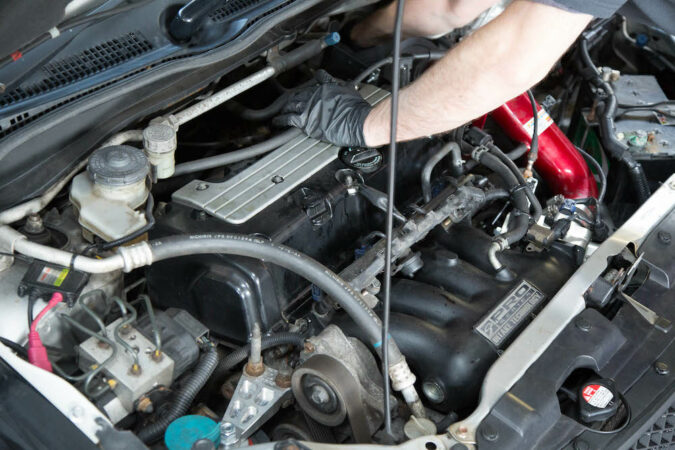The P2096 trouble code isn’t very common, but it can happen. It can be an expensive repair, but sometimes, it’s much more simple than it seems. We’re going to discuss the code’s meaning, causes, repairs, and more in this post. Here’s our table of contents to help you find the relevant information:
P2096 Post Catalyst Fuel System Too Lean Bank 1
The P2096 code translates to “Post Catalyst Fuel System Too Lean Bank 1.” In plain English, your engine is burning a lean fuel and air mixture.
Note that is a generic OBD trouble code, which means this code indicates the same issue whether you have a Nissan, Hyundai, Ford, or any other car brand. Sometimes a P2XXX code is manufacturer-specific, but in this case, it’s a generic code.
Before we get into more detail and how the code occurs, let us explain how an internal combustion engine works:
How Internal Combustion Engines Work
If you already know how an engine works, then you can skip this part. If else, then stick around because this will put things into context. And it’ll be easier to understand how the problem occurs. Don’t worry, we won’t get into too much detail.
An internal combustion engine, whether it’s gas or diesel, works by combusting fuel and air inside the cylinders. This mixture enters the engine via the intake valves, during which the piston inside the cylinder will travel downwards.
Immediately afterward, the piston travels back up to compress the mixture. This compression allows for more energy to be released when the mixture ignites. Once the mixture is compressed, a spark plug (only in gas engines) will ignite a spark that combusts the mixture. This forces the piston to move downward, creating a reciprocating force.
The pistons are connected to a crankshaft at the bottom. This device is a rotating shaft that converts the reciprocating energy into rotating energy. And through a series of gears and shafts, this energy drives your car forward. Or backward depending on which gear you’re in.
So, in essence, your car’s engine works by combusting fuel and air inside the cylinders to drive pistons that power a crankshaft and transfer that energy through a series of gears and shafts. Simple, no?
How The P2096 Trouble Code Occurs
Every internal combustion engine should ideally run on the Stoichiometric fuel-to-air ratio. This ratio is 14.7 parts air to 1 part fuel, the ideal compromise between optimum fuel economy and power output. While it can’t always reach that ratio, the Engine Control Unit (ECU) will always aim to achieve that ratio.
To monitor this, your car uses a couple of oxygen sensors (O2 sensors) in the exhaust system. There are two of them: an upstream sensor that measures the exhaust gases before it gets into the catalytic converter. And the downstream sensor that measures it after the catalytic converter.
Since the P2096 code translates as “Post Catalyst”, it’s the downstream sensor that’s detecting too much oxygen in the converter. The sensor will then pass this information to the ECU to make adjustments.
It will either reduce the amount of air to take or inject more fuel into the engine. If that doesn’t fix the problem, then the ECU will register the error code in the On-Board Diagnostic (OBD) system which triggers a check engine light.
Side note, ‘Bank 1’ refers to the row of engine cylinders where cylinder number 1 is located. If you have an inline-four or inline-six engine, then it only has one bank. If you have a V6 or V8 engine, then bank 2 is opposite bank 1. And the location of cylinder number 1 varies depending on the make and model, check with your owner’s manual.
For V-configuration engines, we suggest that you locate bank 1 and pay close attention to it when troubleshooting. It’s likely the issue stems from there. We’ll get into troubleshooting in a bit. But first, here are the symptoms you might see when you have a P2096 code:
P2096 Symptoms
The P2096 code is a serious problem that you shouldn’t ignore. Even if the root cause turns out to be a simple fix, the code can make the ECU and engine behave erratically and lead to severe damage in the long run. Here are the symptoms you might see:
- Poor fuel economy. Might not be noticeable unless your car has a fuel consumption gauge.
- Reduced performance, especially during acceleration.
- Engine misfires or rough running engine. Engine misfires feel like the engine is hesitating during acceleration.
- Spark knocking. This is when the fuel and air mixture combusts erratically. This will sound like there’s a metal knocking noise from the engine, but sometimes it’s subtle and more like a ticking noise.
- Overheating catalytic converter. You probably won’t notice this, but it can damage the catalytic converter.
These symptoms will affect the driving experience and will not be pleasant. It can also lead to severe engine damage in the long run. Other symptoms might be present as well depending on the cause of the issue, which segues us nicely into our next section:
P2096 Causes & Troubleshooting
Now that you know how an engine works and how the P2096 code occurs, we can get into the causes. There’s quite a lot to cover here, as there’s a myriad of possible causes for this issue.
To help with the troubleshooting process, we recommend scanning the car’s OBD system with an OBD reader for other trouble codes. Other trouble codes can help to narrow down the root cause of this issue, let’s begin:
1. Faulty Oxygen Sensor
First and foremost, the sensor that’s causing this trouble code may be the culprit. Most manufacturers state that O2 sensors typically last 30,000 to 50,000 miles or around 3 to 5 years. So, if your car is around that mark, the sensor may have gone bad.
It’s also possible that the sensor or its wiring is damaged. In any case, this is causing the O2 sensors to give erroneous readings to the ECU and triggering the code.
If you have a faulty downstream O2 sensor, you’ll likely see codes P0136 to P0139. All of these codes indicate erratic readings from the downstream sensor. However, if you see codes P0130 to P0135, then there’s an issue with the upstream sensor.
Note that the sensors may be just fine. Instead, there might be wiring damage. Before you replace the sensor, inspect the wiring for damage. And if there aren’t any, replacing the sensor should fix your problem.
2. Low Fuel Pressure
Low fuel pressure means your car can’t pump enough fuel into the engine, resulting in less fuel and more air being burned. Hence the lean mixture reading from the O2 sensor. Causes for low fuel pressure include a dirty fuel filter, a weak fuel pump, and a clog in the fuel lines.
Low pressure in the fuel delivery system will usually throw a P0087 code, and other more specific codes may appear. You can check the fuel pressure by doing a pressure test in the fuel system using a pressure gauge:
After you verified that you have low fuel pressure, you’ll need to troubleshoot further to find which component is causing it. This can get quite complex, so we recommend checking our guide to the P0087 code.
Meanwhile, if it turns out you have an issue with the fuel injectors, it will usually throw P026X codes. Testing out the injectors is a bit easier. First, take off your engine’s plastic cover and locate the fuel rail—that’s where the fuel injectors sit.
Afterward, inspect the fuel rail for any fuel leakage. If there’s fuel around it, repair this immediately as this can start a fire in your car. Nobody wants that. If there are no leaks, then grab a mechanic’s stethoscope or a long screwdriver. You can listen to the injectors with either of them. Then start the car, and listen to the injectors.
If you’re using a screwdriver, hold it against the injector with the handle end pressed against your ear. You should hear a loud and consistent ticking sound, which indicates the injector is working. If there’s no ticking or if it’s weak and inconsistent, then you have a bad injector that you’ll need to replace. Do this for every single one of your injectors.
3. Air Intake Issues
If the code was caused by air intake problems, there are two possibilities: the air intake tubing has a leak, or the intake’s Mass Airflow (MAF) sensor is faulty.
If you have a leak in the air intake, the car should throw a P2279 code. You’ll need to inspect the air intake tubing and intake manifold for signs of damage or holes, which cause the leak. In my experience, a leak in the system will usually make a wind noise when you rev the engine.
If you hear the wind noise, try to find the source. Have a friend rev the car whilst you try to locate the source. If your car has a turbocharger, check the intercooler hoses as well.
Meanwhile, the MAF sensor sits inside the air intake tubing and measures the total amount of air that enters the engine. If the sensor is faulty, it won’t be able to measure correctly and can cause the engine to take in more air than necessary, resulting in a lean mixture. You’ll likely see a P0101 code if the MAF is faulty.
4. Vacuum Line Leak
Another part of the air intake system is the vacuum line. This system creates an air pressure difference between the inside of the intake manifold and the outside atmosphere. This pressure creates suction that helps the engine to draw in air.
The lines are made out of rubber, and they can tear or crack over time. Or sometimes the lines can just come off from its connection. This creates a leak in the system, and excess air can enter the engine resulting in excess oxygen and a lean fuel and air mixture. The most likely code you’ll see if you have a vacuum leak is P0171.
You can inspect the vacuum line for signs of tear and leaks. If the line is disconnected, simply reconnecting it and clearing the trouble codes in your car’s OBD system may fix the issue.
However, sometimes the tear is so small that it can be hard to spot with the naked eye. If you have a P0171 code and can’t find the leak, you can do a smoke test as shown in the video above to help spot it.
5. Exhaust Leaks
Exhaust leaks can happen either due to corrosion or damage from road debris. And the leak itself can happen in various spots in the exhaust system, such as at the exhaust manifold, and at the exhaust pipes before and/or after the catalytic converter. It can also happen at the muffler but this won’t trigger the P2096 code.
The exhaust leak will allow outside air to enter and mix with the exhaust gases. As a result, there’s more oxygen in the leak and the downstream O2 sensors will detect this. This leads to the ECU thinking the engine is running on a lean fuel mixture, which is why it’s throwing the P2096 code.
There are no trouble codes for an exhaust leak. However, your car will produce a louder exhaust noise when there’s a leak. Sometimes the sound will be so loud that it sounds like you got an aftermarket exhaust. But other times the leak is small and the sound change is more subtle. In my experience, it can sound like a loud ticking noise.
We recommend starting your engine and sourcing where the loud sound is coming from. If it’s coming from the front, then you likely have an exhaust manifold leak. But if the sounds are coming from underneath the car, then the leak is somewhere in the exhaust pipes.
Exhaust leaks can cause the gases to enter the cabin, and you don’t want that. The video we attached above from ChrisFix should help you find the leak if it’s difficult to spot.
6. Plugged Catalytic Converter
The catalytic converter is a filtering device that filters toxins in the exhaust gas by using precious metals. The resulting gas is still harmful, but a lot less than it originally was. Over time, the catalytic converter will get dirty and clog up.
This is less likely to cause the P2096 code, but it can still happen. If you see a P0420 code, then there’s good reason to believe that you have a clogged catalytic converter and that’s the cause for the P2096 code. In this case, you may be able to solve the problem by cleaning the catalytic converter.
However, damage or leaks on the catalytic converter can also happen. If there’s damage to it, you’ll likely have to replace it. And fair warning, this is very expensive.
P2096 Nissan
Car engines are so sensitive that the smallest issue or mistake can trigger the P2096 code. It’s a miracle really that some cars can go 200,000 miles without major repairs. Anyway, just to give you an example of how sensitive it can be, here’s a P2096 code in a Nissan triggered by a very simple mistake in George Melnik’s video:
The video states that the 2015 Nissan Murano just had an air filter replacement before the code appeared. Upon further inspection, turns out the air filter box wasn’t closed properly after the replacement and there was a small gap.
This small gap was enough for excess air to enter the air intake system. And it’s likely it bypassed the MAF sensor, so the engine was getting unmeasured air resulting in excess oxygen, hence the P2096 code.
After reinstalling the air filter box properly, and clearing the OBD system, the code didn’t return and the problem was fixed.
Troubleshooting the P2096 can be very tricky. But inspecting the engine for small mistakes like this can help save you a ton of money. If you have difficulties diagnosing it, we recommend having a trusted repair shop diagnose it for you. A diagnosing process costs $120 on average, provided no major disassembling job is necessary.
P2096 Repairs & Costs
Since there are so many potential causes, the repair cost varies greatly depending on what repair job your car needs. So, here’s a list of the potential repairs and cost estimates:
- O2 sensor replacement – $155 to $500 for each sensor.
- Fuel pump replacement – $220 to $1,000. This varies greatly since a fuel pump is anywhere between $95 and $850, while labor cost is usually $260 at most.
- Fuel filter replacement – $50 to $175.
- Fuel injector replacement cost – $350 to $850.
- Air intake repairs – $200 to $650 (intake manifold usually costs above $500 to replace).
- MAF sensor replacement – $80 to $380.
- Vacuum line replacement – $100 to $320.
- Exhaust leak repair – $50 to $400. A small leak can be patched with epoxy or welding, keeping costs at a minimum. But if the pipes need to be replaced then expect to pay at least $250.
- Exhaust manifold replacement – around $1,000, this replacement job is time-consuming and labor-intensive.
- Catalytic converter replacement – $900 to $2,000. They’re filled with precious metals, hence why they’re expensive (just like the 2006 Honda Pilot catalytic converter or the cost to replace catalytic converter Honda CRV).
- Wiring repairs – $200 to $300 on average.
Note that all of the cost estimates above already include labor costs. And it’s just an estimate, it may be higher in some cars, especially performance and luxury cars.
Some of the repair jobs are doable yourself, such as the O2 sensor and MAF sensor replacement. We’ve linked the ones that we think are doable at home. But for others, such as the exhaust manifold replacement, we recommend leaving it to professionals.
If the cost seems steep, consider scrapping the car or selling it as-is. Compare the cost estimates with your car’s secondhand value. If there’s not much difference, you’re probably better off getting rid of your car.
P2096 Trouble Code Facts
- The P2096 fault code means there is an excess of air and a shortage of fuel within the number one cylinder in a vehicle’s exhaust system, as detected by the Powertrain Control Module (PCM).
- The P2096 code indicates a lean air-to-fuel ratio, which triggers the computer to add fuel to correct the condition.
- A common cause of the P2096 code is an air leak, which introduces extra air into the system, but it can also be caused by limited fuel movement due to failing fuel pumps, clogged filters, or damaged fuel pressure regulators.
- If accompanied by the P0420 code, the catalytic converter is a likely cause, and if registered with the P0100 code, the mass airflow sensor could be the issue.
- Symptoms of the P2096 code include rough idling, knocking, misfiring, labored acceleration, and reduced fuel economy, which trigger the Check Engine Light.
- A specialized scan tool is required to verify the existence of the P2096 code and detect any variables that lie outside of accepted parameters.
- Mechanics diagnose the P2096 code by performing a visual inspection of the exhaust system, testing the vehicle’s performance, inspecting vacuum lines, wiring, and sensors, and conducting multiple tests to identify the specific cause of a too lean fuel mixture.
- Common mistakes when diagnosing the P2096 code include failing to verify the existence of the code, failing to clear the trouble code once repairs have been made, and neglecting to inspect electrical connectors thoroughly.
- While it is possible to continue driving a vehicle that has registered the P2096 code, it is in an owner’s best interest to seek an inspection and repairs as soon as possible to prevent further problems with other components within the exhaust and other systems.
- Repairing a vacuum or other hose/line leak, replacing the catalytic converter, fuel filter, fuel pump, fuel pressure regulator, oxygen or mass airflow sensor, or spark plugs are actions that may fix the P2096 trouble code.
P2096 FAQ
If you have unanswered questions about the P2096 trouble code, check our answers below:
How To Fix Code P2096
To fix this code, you’ll need to find the exact cause. It can be caused by a faulty oxygen sensor, air intake leaks, vacuum line issues, low fuel pressure, bad fuel injectors, exhaust leaks, and even a clogged catalytic converter. You’ll need to find the cause first, then repair or replace the necessary parts. Afterward, clear the trouble code from the OBD system to get rid of the check engine light.
What Does P2096 Code Mean
The P2096 code translates to “Post Catalyst Fuel System Too Lean Bank 1.” This essentially means that the downstream oxygen sensor (the one after the catalytic converter) is detecting too much oxygen in the exhaust gases, which indicates the engine is running lean (more air, not enough fuel). But it could also mean that the oxygen sensor itself is faulty.
What Causes Code P2096
There are multiple possible causes, including a faulty oxygen sensor, air intake leaks, vacuum line issues, low fuel pressure, and exhaust leaks among others. Scan the car’s OBD system for other trouble codes to help narrow down the possible causes. And then you can troubleshoot from there.
Is P2096 Serious?
It’s a serious issue. Regardless of whether or not the cause is serious, an erroneous reading from the oxygen sensor will cause erratic behavior in the ECU and engine. For example, the ECU may inject more fuel when it isn’t necessary. This causes a rich fuel mixture, which can lead to excess carbon buildup, rough idling, and catalytic converter failure. Best to repair the P2096 code before further damages occur.
P2096: Wrap Up
To summarize, the P2096 means that the downstream oxygen sensor is reading that there’s a high oxygen level in the exhaust gas. This could be a faulty sensor, but it can also mean that the engine is running lean (more air, not enough fuel).
If the engine is running lean, you’ll need to troubleshoot further on what’s causing and there’s a myriad of possibilities. It could be because the engine is not getting enough fuel, such as due to low fuel pressure or faulty fuel injectors.
It could also be because the engine is getting too much unmeasured air. Such as an intake leak, faulty MAF sensor, or a vacuum leak. And one more possibility is that there’s a leak in the exhaust system, which increases the oxygen level in the exhaust gas, leading the sensor to believe that your engine is running lean.
Whatever the cause, it’s best to troubleshoot and fix the problem as soon as possible. The P2096 code not only causes driving discomfort but can also further damage the engine if left unserviced. Hopefully, this has been a helpful guide for you and good luck!





